Wrestling Meccas is a series of features at Last Word on Pro Wrestling that looks at the history of some of professional wrestling’s most iconic venues, from large stadiums to small indie havens. This edition looks at the Hammerstein Ballroom in Manhattan, New York, and its wrestling history from the original home of Monday Night Raw to an iconic mecca of indie wrestling in New York City.
On Saturday night, Game Changer Wrestling (GCW) made a huge announcement prior to their main event match featuring Jon Moxley vs. Nick Gage, revealing that GCW would be running its first show from the legendary Hammerstein Ballroom in the Manhattan Center in New York City on January 23, 2022. It would make GCW only the 6th wrestling promotion to work in the building since it began hosting pro wrestling in 1993, although the building has been in operation for over 100 years. For this edition of the Wrestling Meccas series, we take a long look at the history of the Hammerstein Ballroom and the building it’s part of, the Manhattan Center.
https://twitter.com/GCWrestling_/status/1447039716164083715
The Manhattan Center – Grand & Hammerstein Ballroom
The Manhattan Opera House, 1906-1939
The venue was originally built in 1906 by Prussian composer Oscar Hammerstein I. Hammerstein had emigrated to America in 1864 from what is now modern-day Poland and began his new American life composing and becoming a patron of the arts, resulting in his creation of the Manhattan Opera House in 1906. Hammerstein’s grandson, Oscar Hammerstein II, would go on to become one of America’s greatest songsmiths of the first half of the 20th century, most notably in partnership with Richard Rodgers.
The Manhattan Opera House was actually the elder Hammerstein’s eighth theater, having built multiple theaters throughout the New York boroughs, starting with the Harlem Opera House in 1889. By 1922, Hammerstein had sold the venue to the Scottish Rite Free Masons, and it became a Free Mason Temple as well as a performance venue. Under the ownership of the Scottish Rite, the Manhattan Opera House added its second venue in the building, The Grand Ballroom, on the second floor.
Manhattan Center, 1939
In 1939, the Manhattan Opera House changed its name to the Manhattan Center – a name that continues to this day – and it moved away from the Opera and into the world of big band performances. The venue would become a hub for live performances of a variety of musical tastes over the decades, such as Perry Como (1959), Harry Belafonte (1952), The Grateful Dead (1971), and Bob Marley (1975), as well as a routine recording venue for radio broadcasts, until the 1970s, when it was purchased by Reverend Sun Myung Moon’s Unification Church in 1976.
The Church invested heavily in restoring the Manhattan Center, and by the mid-1980s, it had state-of-the-art studios and became a multi-media hotspot in New York City. In 1988, in a hindsight look at what could be foreshadowing into the wrestling world, the rock band Living Colour recorded the performance footage for their video for “Cult of Personality” in the Grand Ballroom of the Manhattan Center, a song that became synonymous with indie wrestler CM Punk in his Ring of Honor days, followed by use in both WWE and, currently, All Elite Wrestling (AEW).
The Arrival of Pro Wrestling at the Manhattan Center, 1993
Professional wrestling finally arrived in the building in January of 1993, when the World Wrestling Federation (WWF) launched its flagship program, WWF Monday Night Raw, live from the venue’s Grand Ballroom on January 11, 1993. The Grand Ballroom was home for the first eleven episodes of Monday Night Raw and continued to be one of the frequent stops for the broadcast until October of that year before it began traveling more to outside venues. On March 1, 1993, Bret “Hitman” Hart would become the first World Champion to defend his title in the building, defending against Fatu (pre-Rikishi), in the episode’s main event. The only other WWF World title defense at the Grand Ballroom was Yokozuna defending against Crush on July 5, 1993. In early 1997, WWF returned to the Grand Ballroom for a one-night return, that featured an invasion from the stars of Extreme Championship Wrestling (ECW). Little did anyone know that while February 24, 1997 would mark ECW’s first foray into the building on 311 West 34th Street in downtown Manhattan, it would soon become hallowed walls for the rise of the U.S. indie scene thanks to Vince McMahon‘s “special guests” that evening.
https://www.youtube.com/watch?v=Q0M-vnTX8pA
The Hammerstein Ballroom Restored, 1997
In 1997, the Unification Church directed its attention back to the building’s 3,000-seat venue, which was fully restored and renamed the Hammerstein Ballroom (in honor of the building’s founder). While the Grand Ballroom had been the venue of choice in the building, it only held approximately 1200 fans. With the Hammerstein, it opened up a far larger venue. But by this time, the WWF was beyond even 3,000 seat venues for its events, so the Hammerstein would remain used more by music, religious and cultural events. That is until ECW came knocking in the year 2000. On August 25, 2000, ECW held its first event at the Hammerstein Ballroom, a venue twice the size of the Grand Ballroom that they had invaded just three years earlier with the WWF. Over two nights, they taped content for several episodes of ECW on TNN, which saw the crowning of new ECW World Tag Team champions in Mikey Whipwreck & Tajiri, Kid Kash beat Rhino for the ECW World Television title, and Justin Credible defend his ECW World title against Steve Corino. On December 13, 2000, ECW returned to the Hammerstein, this time for the PPV Massacre on 34 Street, which saw ECW World Champion Steve Corino defend his belt against Jerry Lynn and Justin Credible in a triple threat. Two more episodes of TV were recorded the following day and in January of 2001, ECW held its final PPV, Guilty As Charged, at the Hammerstein Ballroom, which saw the ECW World title change hands twice that night – first when Sandman defeated Steve Corino and another challenger Justin Credible, followed quickly by Rhino defeating Sandman, making Sandman the first wrestler to win a World title in the Manhattan Center. Sadly, three months later in April of 2001, ECW went bankrupt and closed its doors.
WWE Returns for One Night Stand
By 2005, the Monday Night Wars were long dead. Soon after ECW folded in early 2001, WWE’s chief rival, World Championship Wrestling (WCW) had been bought out by Vince McMahon, and the intellectual properties of ECW had also been acquired. While ECW wrestlers were now active members of the WWE landscape following the end of the Invasion angle, a resurgence in ECW nostalgia saw WWE capitalize on the wave by producing an ECW event, One Night Stand, on June 12, 2005. In honor of the spirit of ECW, the card featured WWE wrestlers who came from ECW, as well as a few special returns, and the entire night was held at the Hammerstein Ballroom, marking WWE’s first official event in the Hammerstein venue in Manhattan Center.
The success of the show, which saw 2,500 fans in attendance, led to the launch of ECW as a new brand within the WWE Universe. Much like NXT would do years later, it paired some veterans with a large crop of rising young talents. WWE would hold a second One Night Stand a year later, on June 11, 2006, which saw ECW Original Rob Van Dam defeat John Cena for the WWE World title, making it the first and only time the WWE Championship would change hands in the Hammerstein Ballroom. They would return once more in August of that year for a taping of ECW on SyFy, which saw new ECW Champion The Big Show lose by DQ to Batista in the main event. It would be the last time the WWE would appear at the Hammerstein Ballroom (although they would return to the Grand Ballroom in 2018 for the 25th Anniversary of Raw episode).
Ring of Honor Enters The Ballroom
With WWE now long past venues the size of either of the main venues in the Manhattan Center, it would be up to the rising tides of the U.S. independent scene to take over the building and continue its legacy as one of the meccas of the pro wrestling world. And in 2008, it was Ring of Honor who launched that initiative, when they held ROH A New Level at the Hammerstein Ballroom on October 5, 2008 (ROH had been in the building earlier, having started running shows at the Grand Ballroom in 2006). Headlined by ROH World Champion Nigel McGuinness defending his title against Claudio Castagnoli (better known today as WWE’s Cesaro), the event drew 2,300 fans for ROH’s Hammerstein debut, with a card that also featured Bryan Danielson defeating Pro Wrestling NOAH‘s Noamichi Marufuji and El Generico (Sami Zayn) & Kevin Steen (Owens) defeat No Remorse Corps’ Rocky Romero & Davey Richards.
They returned twice more that year, for August’s ROH Death Before Dishonor VI (where Brent Albright defeated Adam Pearce for the first NWA World’s Heavyweight Championship change in the Hammerstein) and December’s ROH Final Battle 2008, which featured McGuinness defending his ROH World title against Marufuji, and then headlined by Bryan Danielson overcoming Takeshi Morishima. The Hammerstein Ballroom has gone on to become one of ROH’s larger venues for big events since then, housing their biggest event of the year, Final Battle, seven times (2008, 2011, 2012, 2013, 2017, 2018, 2019), as well as several other PPVs and episodes of ROH TV (the building’s Grand Ballroom also hosted Final Battles in 2006, 2007, 2009, and 2010).
The ROH World Championship changed hands multiple times in the Manhattan Center starting in 2006, when Homicide defeated Bryan Danielson at Final Battle 2006 in the Grand Ballroom, with other Grand Ballroom World title winners including Tyler Black (Seth Rollins, 2010), Roderick Strong (2010), and Eddie Edwards (2011). In 2011, Davey Richards became the first man to win the ROH World title at the Hammerstein Ballroom, followed by other Hammerstein World Championship winners Jay Briscoe (2013), Kyle O’Reilly (2016), and Dalton Castle (2017). ROH discontinued working the Grand Ballroom in 2013 and has continued to use the Ballroom up until mid-2019 before the COVID-19 pandemic hit by the end of the year.
TNA Makes an IMPACT in the Manhattan Center
Following on ROH’s lead, Total Nonstop Action (TNA) made their own Manhattan Center debut on September 6, 2010, when they held a House Show event in the Grand Ballroom, that saw TNA World Heavyweight Champion Samoa Joe defend his title in a four-way match against Booker T, Christian Cage, and Kurt Angle. Three weeks later, they debuted at the Hammerstein Ballroom for another House Show, which saw a rare House Show title change, when Amazing Red defeated Jay Lethal for the TNA X-Division title. It would be the one and only time that TNA/IMPACT Wrestling would perform at the Hammerstein Ballroom.
But they did continue using the Manhattan Center and the Grand Ballroom for tapings of both IMPACT Wrestling and Xplosion! throughout 2014 and into early 2015, including specials like Destination X in June of 2014, Hardcore Justice and No Surrender in August, and Lockdown in January of 2015. Apart from Samoa Joe’s World title defense in 2010, other TNA World title defenses that took place in the Grand Ballroom included Bobby Lashley twice in 2014. He also won his second TNA World title on an episode of IMPACT Wrestling filmed at the Grand Ballroom in January of 2015. Gail Kim had multiple title defenses of the TNA Knockouts title at the Manhattan Center throughout 2014 as well, as did Taryn Terrell in 2015. In June of 2014, Samoa Joe won the X-Division title at the Grand Ballroom as well. IMPACT Wrestling has not been at the Manhattan Center since 2015.
East Meets Hammerstein: New Japan Makes Hammerstein Debut
In February of 2014, New Japan Pro Wrestling (NJPW) entered into an international partnership with Ring of Honor, which lead to talent shares and combined tours, and it was on tour for their first ROH/NJPW War of the Worlds tour that the stars of NJPW made their debut at the Hammerstein Ballroom on May 17, 2014. The card saw IWGP Heavyweight Champion AJ Styles defend his title in a triple threat against Kazachika Okada and Michael Elgin, as well as ROH World Champion Adam Cole retain against New Japan’s Jushin ‘Thunder’ Liger. Bobby Fish & Kyle O’Reilly (reDRagon) defeated The Young Bucks that night for the ROH World Tag Team titles. NJPW returned again in May of 2017 as part of another joint War of the Worlds tour, with ROH World Champion Christopher Daniels retaining against Cody and Jay Lethal, as well as Hiroshi Tanahashi defeating Adam Cole. New Japan finally had their first solo event at the Hammerstein Ballroom on September 28, 2019 at NJPW Fighting Spirit Unleashed, which saw the main event of Los Ingobernables de Japon‘s EVIL & SANADA defeat Okada & Kota Ibushi, while LIJ’s Tetsuya Naito, Shingo Takagi & BUSHI lost to the trios unit of Hiroshi Tanahashi and The Rock N’ Roll Express.

It’s been close to two years now since the last wrestling show at the Manhattan Center, NJPW’s Fighting Spirit Unleashed in September of 2019, but in January of 2022, Game Changer Wrestling is bringing that hungry spirit back into the Hammerstein Ballroom, in what is surely going to be GCW’s biggest show of their six-year career.
Check out our Wrestling Meccas features archive for more!
Stay tuned to the Last Word on Pro Wrestling for more on this and other stories from around the world of wrestling, as they develop. You can always count on LWOPW to be on top of the major news in the wrestling world. We provide you with analysis, previews, videos, interviews, and editorials on the wrestling world.






